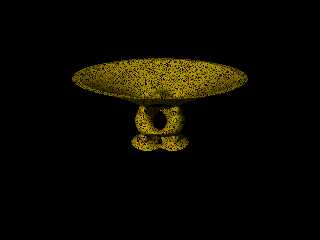|
 |
"Droj" <803### [at] droj de> wrote:
> When you mentioned to use the function f_r (x, y, z) - although I do not have a
> clue what it does (there is no comment in functions.inc)
You need to check the wiki entry under functions.inc
f_r(x,y,z): When used alone, the R function gives a surface that consists of all
the points that are a specific distance (threshold value) from the origin,
So basically you're just comparing your surface to a spherical shell.
At least you were able to work something out and get a decent result.
Isosurfaces can certainly be tricky, especially since we don't have vector
functions and certain inbuilt functions that other software packages pull from
libraries.
Chris R does everything with isosurfaces - maybe he can focus his highly trained
mind on it.
- BW de> wrote:
> When you mentioned to use the function f_r (x, y, z) - although I do not have a
> clue what it does (there is no comment in functions.inc)
You need to check the wiki entry under functions.inc
f_r(x,y,z): When used alone, the R function gives a surface that consists of all
the points that are a specific distance (threshold value) from the origin,
So basically you're just comparing your surface to a spherical shell.
At least you were able to work something out and get a decent result.
Isosurfaces can certainly be tricky, especially since we don't have vector
functions and certain inbuilt functions that other software packages pull from
libraries.
Chris R does everything with isosurfaces - maybe he can focus his highly trained
mind on it.
- BW
Post a reply to this message
|
 |
|
 |
MichaelJF <fri### [at] t-online de> wrote:
> > It's probably as close to the original as it can get.
> Agreed! I think, the only improvement is to close the surface by
> removing the open statement
>
> Best regards
> Michael
Thanks, Michael, for the hint to remove 'open'.
I realised that there was still something wrong at the rim.
Your hint was the icing on the cake!
Droj de> wrote:
> > It's probably as close to the original as it can get.
> Agreed! I think, the only improvement is to close the surface by
> removing the open statement
>
> Best regards
> Michael
Thanks, Michael, for the hint to remove 'open'.
I realised that there was still something wrong at the rim.
Your hint was the icing on the cake!
Droj
Post a reply to this message
Attachments:
Download 'iso_devil_plate.png' (382 KB)
Preview of image 'iso_devil_plate.png'

|
 |




![]()